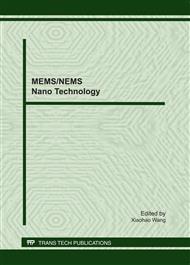p.461
p.465
p.471
p.475
p.481
p.487
p.492
p.497
p.503
A Curvature-Compensated, High Power Supply Rejection CMOS Bandgap Reference for MEMS Micro-Accelerometer
Abstract:
The reference is an important part in the accelerometer system. With the development of science and technology, the request of the performance of accelerometers is increasingly higher and the precision of reference directly affects the performance of accelerometers. Therefore, a reference voltage applicable to accelerometers is presented based on the analysis of basic principles of conventional bandgap reference (BGR) in this paper. A high-order curvature compensation technique, which uses a temperature dependent resistor ratio generated by a high poly resistor and a nwell resistor, effectively serves to reduce temperature coefficient of proposed reference voltage circuit and to a large extent improve its performance. To achieve a high power supply rejection ratio (PSRR) over a broad frequency range, a pre-regulator is introduced to remain the supply voltage of the core circuit of BGR relatively independent of the global supply voltage. The proposed circuitry is designed in standard 2.0μm CMOS process. The simulated result shows that the average temperature coefficient is less than 2ppm/°C in the temperature range from -40 to 120°C. The improvement on temperature coefficient (TC) is about 10 times reduction compared to the conventional approach. And the PSR at DC frequency and 1kHz achieves -107 and -71dB respectively at 9.0V supply voltage.
Info:
Periodical:
Pages:
481-486
Citation:
Online since:
June 2011
Authors:
Keywords:
Price:
Сopyright:
© 2011 Trans Tech Publications Ltd. All Rights Reserved
Share:
Citation:


